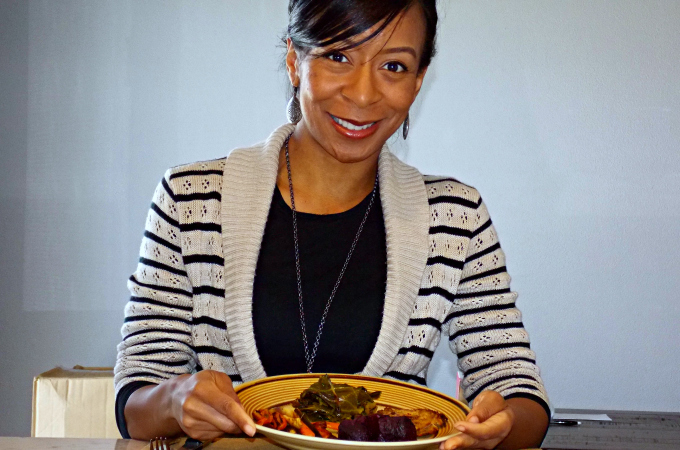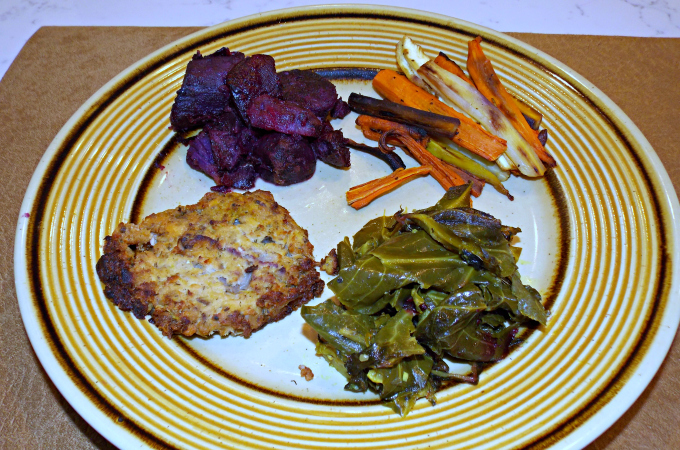
Diversity in AIP is a story series showcasing the wide variety of people from different backgrounds adapting AIP to not only support autoimmune healing, but also to honor important cultural, religious, ethnic, or national food traditions. We are sharing these stories regularly to encourage folks of similar backgrounds to join our Autoimmune Wellness movement and to inspire the community as a whole about the growing reach of our healing message. If you are interested in sharing your story, please let us know by filling out our interest form.

This month’s “Diversity in AIP” story comes from Lonnetta. Lonnetta is African-American and after struggling with optic neuritis, she found healing AIP opened her life up in unexpected ways. Her enthusiasm is infectious and jumps right out in her story.
Do you have an autoimmune disease or chronic illness? If so, how long have you been dealing with it (them) and when did you get your diagnosis?
In 2007, I was diagnosed with an autoimmune condition, optic neuritis. I since had two relapses in 2007-2008. Within the past year, a new level of testing has revealed various digestive health related ailments, including leaky gut, candida and nutrient malabsorption. Additionally, I have been diagnosed with poor mitochondrial function, uterine fibroids, hormone imbalance and have battled acne since my teenage years. With more than 80% of the immune system residing in the gut, I know that targeting this area is key to me achieving the most optimal health for me.
When did you discover AIP and what was your first indication that it was working for you?
In 2015, I felt God challenging me in the areas of my understanding of health and nutrition…what I put in my body and on my body. Enter a season of research and learning, which ultimately led me to pursue naturopathic and functional medicine doctors. The aim to uncover and treat the underlying causes of disease spoke volumes to me. After getting a full panel of functional medicine testing – I learned about so many underlying issues that I didn’t know were there. My doctor immediately “prescribed” the AIP. I should mention this was just before Thanksgiving, but I didn’t let that stop me. I relied on my AIP cookbooks, the AIP Wellness community and bloggers for substitute recipes, support and resources.
Within one month, I lost about 10 pounds, experienced deeper sleep and had such great energy and more. My skin began to purge so I had break outs initially, but cystic acne was no more. For the first time, I saw the direct correlation between my skin/acne woes and diet! All this time, I’d spent money on creams and prescriptions, when it was my diet that had the potential cure. Additionally, without over sharing, my regularity improved substantially and I didn’t have the uncomfortable bloating and fullness that I’d experienced before.
Lastly, following the AIP has forever influenced the way I eat – for the better. The reintroduction portion of the AIP was so eye-opening and opened the door to much needed lessons. I didn’t know I had food sensitivities and how certain foods were impacting my body, including causing inflammation. My understanding of food sensitivities, allergies and addictions has been expanded. I had reactions to several foods during the re-introduction – including nightshades, gluten and dairy. I have since committed to a dairy free and gluten free lifestyle and eating clean/whole foods. It’s a journey!
Do you have an important cultural, religious, ethnic, or national background that plays a role in your dietary choices? If so, how have you honored your food traditions while following AIP?
As an African-American growing up in the Midwest and South, I have always had a love of food – though not always the healthiest. I grew up in a household where my mom cooked for us and one time a week we might splurge and get pizza or another kid favorite. We ate somewhat healthy based on the Standard American Diet guidelines I suppose. Sunday dinners were so yummy! An example meal might be slow cooked roast, candied yams, greens, super cheesy macaroni and cheese and peach cobbler for dessert. Sometimes, we can overuse starches and processed foods, and AIP has helped me re-evaluate this for the better.
Being on the AIP put me in a position that required me to think smarter about food options, menu planning and the purpose of ingredients. I don’t feel deprived anymore. I now have a new bank of food ingredients to create new meal options or modify some of the foods that I grew up with! Last year, I cooked a complete AIP Christmas dinner for my family to show them how eating (truly) healthy is not depriving but can be satiating and rewarding – especially if you’re willing to get creative.

Can you share some adaptations you’ve made to special dishes to make them work with AIP?
There are so many foods that I denounced in the past, but because of this journey, my taste buds are changing and crave more nutrient dense, colorful foods. I am eating (and loving) foods that I thought I hated or never had before AIP – such as beets, brussels sprouts, spaghetti squash, and plantains, just to name a few. I also have fallen in love with purple sweet potatoes!
There are several dishes I love and modified them to use AIP approved ingredients. Some include:
- Magic Chili – This was a surprise winner for me. Instead of tomato sauce and beans, the recipe calls for unexpected ingredients that I personally don’t think of when it comes to chili. Beets, carrots, cinnamon and turmeric. I now love this stuff!
- Tacos – Cut out the traditional corn taco shells, shredded cheese and tomatoes/salsa. I can now quickly whip up shells out of plantains. I make my own taco seasoning as well as fresh guacamole. I use spaghetti squash seasoned with cilantro and nutritional yeast for my “cheese.” Load it up with some fresh greens and dig in!
- Ice cream – I LOVE ice cream, so giving up dairy hit me hard… but not for long! I soon found recipes to make fruit sorbets. Also, I found a delectable recipe for vanilla ice cream that only requires 3 ingredients – coconut milk, alcohol free vanilla and pure maple syrup.
- Smoothies – As I aim to adopt a more nutrient dense diet, healthy smoothies have been a convenient and impactful addition. I have transitioned to more veggies than fruit in my mixes and love trying different recipes based on what my body needs more of. They taste great and my body responds well to them.
Are there any foods that were part of important food traditions you followed previously, but still work great within the AIP framework?
Those based on dairy, gluten and processed ingredients are the ones that I have just cut out. Some culturally popular foods still work well with some minor ingredient modifications such as greens, sweet potatoes and most meats (with the exception of fried meats).
Has it been difficult to garner the support of family or friends in your culture, religion, ethnicity or country, while following AIP? If so, what tips would you give to others from your same background who want to try AIP?
When I’ve shared my journey, most focus on what I can’t eat while I focus on all the food that I can eat. The exclusions of the AIP showed me how limited my previous (SAD) diet was. I have greater diversity in my food options following AIP than before I started.
I would love if everyone in my family would adopt AIP for three months – just to try it. I think they would be pleasantly surprised. It would have such a unique, transformational impact on each of them– physically, emotionally and spiritually. I won’t stop trying!
Throughout my changes in the past year or two, I have learned that food is very personal to people. I’ve also learned until people find and embrace their own “why,” it is hard for me to convince them to make important lifestyle/diet changes that could lead to substantial improvements in their life and health.
One of the defining moments for me on the AIP was when I realized that I hated having leaky gut and candida (or disease in general) more than I loved eating any type of food. That equation helps me put things in perspective. Mixed in with burgeoning faith and discipline, I know I cannot go back to how I used to eat. When I am eating something – I think about whether it is improving my health or robbing me of it.
Some tips that I have found to be most helpful in encouraging others to make healthy lifestyle changes, such as AI:
- Do model healthy AIP behavior and benefits. Eventually, people will ask you what you’re doing. As Muhatma Ghandi said, “be the change you want to see in the world.”
- Don’t pressure others or overly preach to them about what they should be doing. You don’t want to come off judgmental.
- Do be there to encourage them and celebrate even the smallest of steps.
- Don’t overwhelm them with resources but deliver them with care and concern based on how they best receive information.
- Do offer to be there to provide support and input when they feel ready.
- Do support your loved ones in thinking about their own “why.”
Did any aspect of your healing journey with AIP deepen your connection to your culture, religion, ethnicity, or nationality and the food traditions it follows?
The AIP was at first intimidating because of ALL of the food it required me to “give up.” After four months of strict AIP adoption, I found I “gained” exponentially more than I thought I was giving up. I learned about so many other foods and spices that I had neglected my whole life! It has opened up a whole new world of culinary delight that I look forward to further exploring.
My faith has been strengthened during this time and brought to a new level of awareness, spiritually and relationship with God. I honestly feel that the AIP is more than a diet. For me, it was the beginning of a cleansing, renewal and healing process. My mind is clearer. I have room to be creative and walk towards my life’s purpose in a fresh way.
Who knew changing my diet – would ultimately give way to me changing my life? The faith and discipline it took me to truly follow the AIP is pouring over into other areas of my life and I am better because of it. I am thankful for the AIP Wellness community – it has, and continues to be, a blessing.
Would you like to share your Diversity in AIP story? Let us know by filling out our interest form.
















4 comments
I love this! Lonnetta, thanks for sharing your experience. In the last year, I have also had to give up gluten, dairy, and nightshades. Nightshades have been the hardest for me coming from a family that ate a lot of Italian food and marrying a man from India. I also had to just stop eating some foods altogether, but my husband and I have done a lot of experimentation with recipes and found some that we really enjoy. I haven’t tried the Magic chili yet, but I think I will give it a go. I also like your suggestion for tacos. Thanks!
Very interesting article! I learned so much that I did not know regarding this condition. Lonnetta gave some excellent suggestions for making changes to ones diet that would benefit almost anyone trying to eat healthy. Not gonna lie, that plate of food looked amazingly delicious. I greatly admire Lonnetta’s dedication to doing whatever it takes to manage her medical challenges. It appears that she is rocking it!
This was an amazing interview. Thank you so much for sharing, Lonnetta. It is so encouraging to see an African American woman using AIP for healing. I am beginning my AIP journey after a diagnosis of Connective Tissue Disease (with signs of Scleroderma and Lupus); Inflammatory arthritis and Raynauds. Angie and Mickey, thank you for all that you do to bring AIP to diverse communities and to help us connect through shared culture and experience.
You are so welcome Tiffany! We want to make sure everyone has a place to heal in this community and sharing Lonnetta’s inspiring story is a great way to blaze that trail. We so glad you are here w/ us!